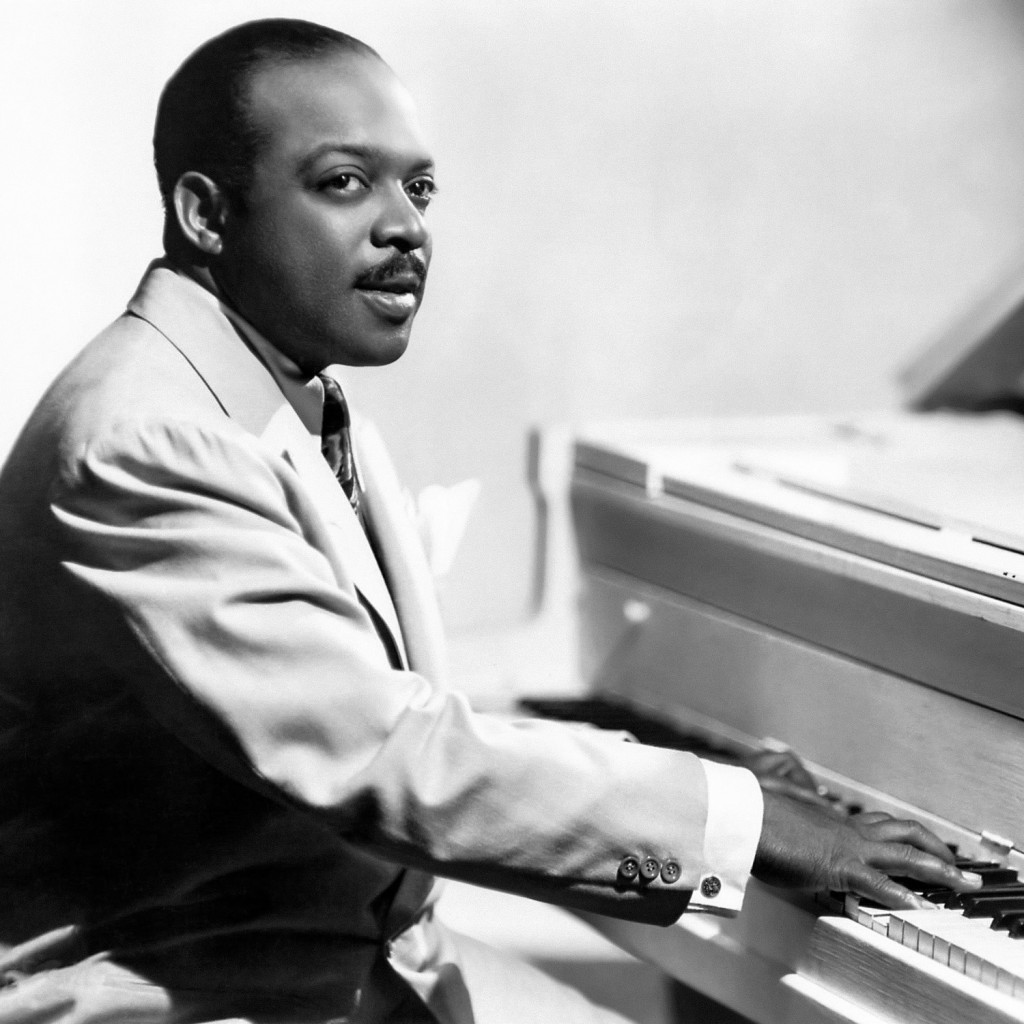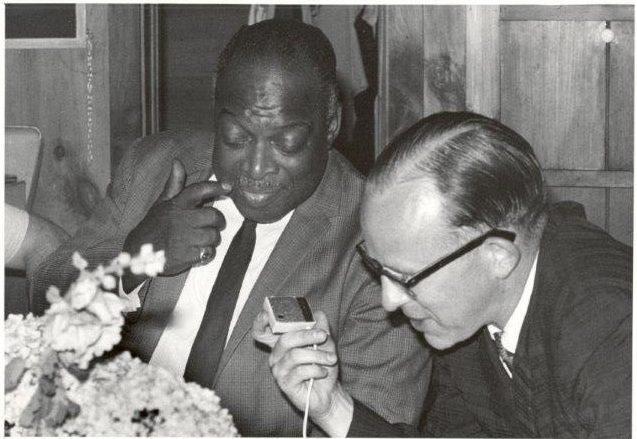
In 1950, for the first time since 1935, there was no Count Basie Orchestra. By then, most of the swing era big bands were either no longer in existence or battling for their existence with limited success. Benny Goodman, Artie Shaw, Charlie Barnet, and Woody Herman (who would soon form a new band) were no longer leading orchestras while Glenn Miller and Jimmie Lunceford had passed away a few years earlier. Still, it must have been a shock that Basie’s band, which had symbolized swing, had broken up in August 1949 due to financial problems and an apparent decline in the public’s interest in swinging big bands.
Count Basie, who was 45, had no intention of giving up music. He put together a small combo that had three or four horns and a three-piece rhythm section. Freddie Green, Basie’s rhythm guitarist since 1937, was originally left out of the group for economic reasons. However one night before a gig, Green simply showed up and set up his equipment. He went back to being a part of the Basie band without the pianist actually hiring him.
While Basie’s first recording session in 1950 found him leading an octet that included trumpeter Harry “Sweets” Edison, trombonist Dicky Wells, and both Gene Ammons and Georgie Auld on tenors, by the summer he was leading what was billed as the Count Basie Sextet (it was actually seven pieces) with trumpeter Clark Terry (who had been in Basie’s big band the previous year), clarinetist Buddy DeFranco, tenor-saxophonist Wardell Gray, Freddie Green, bassist Jimmy Lewis, and drummer Gus Johnson. Most unusual for two reasons was the inclusion of DeFranco. Basie’s orchestra had been one of the first swing bands not to utilize a major clarinet soloist, starting a trend of clarinetists having a much more minor role in most big bands. In addition, DeFranco was the first white musician hired to work regularly with Basie. A brilliant clarinetist who by 1950 was the pacesetter on his instrument, DeFranco was a master of bebop who also fit easily into swinging settings.
Count Basie continued with his small group through 1951, making a few excellent recordings and appearing in some film shorts, but he clearly missed his big band. On April 10, 1951, he led a four-song session with a specially assembled orchestra that included the members of the septet and such future Basie-ites as altoist Marshall Royal (who had replaced DeFranco in Count’s small group) and baritonist Charlie Fowlkes. Most memorable was Wardell Gray’s showcase on “Little Pony” which was Neal Hefti’s first arrangement for Basie. A similar group was featured on a radio broadcast in May but otherwise Basie did not record for the next eight months.
Then, against all odds, Count Basie appeared at the helm of a new big band, one that would later be nicknamed his “New Testament” orchestra as opposed to his earlier “Old Testament” outfit. 1952 was an unlikely time to start a jazz orchestra unless it was a ghost band or one that was clearly based upon an earlier sound such as Glenn Miller’s. However Basie had no interest in merely repeating the past. Other than the leader, only two of the permanent members of the new orchestra (Freddie Green and trumpeter Joe Newman) had been with his earlier big band. While the Basie orchestra of 1935-49 was particularly notable for its soloists, riff-based originals, and for sounding quite spontaneous (often with the flavor of a jam session), the new Basie band would have tight arrangements and be a bit more modern while leaving room for individual solos. The rhythm section would be as light and floating as it was earlier with the leader making every perfectly placed note count during his spots, but it was up to the horn soloists and the arrangers to conform to the swinging Basie style and sound rather than the other way around. Once the Count Basie Orchestra settled on its personnel and had enough arrangements, it became the most consistent of all big bands. It achieved the very difficult task of always sounding enthusiastic and fresh while never altering its sound.
Signed to Norman Granz’s Clef label by the beginning of 1952 and having Birdland in New York as a home base (with Lester Young guesting on a few radio broadcasts), the band’s personnel quickly solidified and the new Basie sound emerged. The key soloists in 1952 were Newman on trumpet, trombonists Benny Powell and Henry Coker, and the contrasting tenors of Eddie “Lockjaw” Davis and Paul Quinichette. Davis had a tough and big sound inspired by Coleman Hawkins while Quinichette was a near sound-alike of Lester Young. In fact while Young had the nickname of Pres or Prez (short for president), Quinichette would be called the Vice Prez.
With Marshall Royal leading the saxophone section and arrangements provided by Neal Hefti, Ernie Wilkins (who for a time played alto with the band), and Buster Harding, the Basie Orchestra was ready. In addition to the excellent big band recordings that they made in 1952 (which included “New Basie Blues” and “Fancy Meeting You”), Basie was also persuaded by Norman Granz to occasionally record with a small group. Now and then he would switch to organ, showing what Fats Waller had taught him 25 years earlier.
By 1953 the Count Basie Orchestra was universally considered a surprise success as it fit comfortably into the jazz scene. The tenors Davis (who would return numerous times in the future) and Quinichette were succeeded by Frank Wess and Frank Foster. Wess, who had a similar tenor sound as Foster, became the first major flute soloist to be regularly featured with a jazz big band. In addition, both Foster and Wess contributed arrangements to the growing Basie repertoire. With bassist Eddie Jones and drummer Gus Johnson joining Basie and Green in the rhythm section and Thad Jones sharing trumpet solos with Newman starting in 1954, everything was in place for Basie’s continued success except for one thing. The band lacked a regular vocalist. Jimmy Rushing had been an important part of Basie’s success in the 1930s and ’40s but, up to this point, other than Al Hibbler being featured on one record date and the obscure Bixie Crawford touring Europe with the band in 1954, they did not have a singer.
The band was able to get by with instrumentals since their book now included Hefti’s “Two For The Blues,” Frank Foster’s “Blues Backstage” and “Down For The Count,” their longtime tenor feature “Jumpin’ At The Woodside,” and Basie’s classic theme “One O’Clock Jump.” But in 1955 the Basie Orchestra really broke through to the top when Joe Williams joined the band. While Williams had been singing professionally (including with Jimmie Noone, Les Hite, Coleman Hawkins, Lionel Hampton, and Andy Kirk) since 1937, the 36-year old was still an unknown to the general public.
The 1955 album Count Basie Swings, Joe Williams Sings changed all of that. Williams’ classic recording of “Every Day I Have The Blues” and his memorable versions of such songs as “All Right, Okay, You Win,” “In The Evenin,” and “The Comeback” made him famous in the jazz world and an indispensable part of the Basie band for the next six years. Also in 1955, the Basie Orchestra recorded their very popular April In Paris album which included their timeless version of the title cut (with an arrangement based on organist Wild Bill Davis’ earlier recording), Freddie Green’s “Corner Pocket” (later recorded by singers as “Until I Had You”), and Frank Foster’s most famous composition, “Shiny Stockings.”
From then on, there was never any doubt that the Count Basie Orchestra was permanently back. With its stable personnel (Sonny Payne was now driving the band on drums), constant work including appearances at jazz festivals and European tours, regular string of recordings, and new contributions by its arrangers, Basie had created a swinging institution. Rock and roll may have begun to dominate the charts but for the next decade it did not matter.
The Count Basie Orchestra recorded a successful album with Ella Fitzgerald and toured and recorded with Sarah Vaughan. At the 1957 Newport Jazz Festival, which was fortunately recorded, Basie welcomed such alumni as Lester Young, drummer Jo Jones, tenor-saxophonist Illinois Jacquet, and Jimmy Rushing (plus Roy Eldridge) back to his band for a set of exciting and historic music. Later in the year, Al Grey became the band’s trombone soloist and Eddie “Lockjaw” Davis returned with Wess moving over to the alto chair. And then, with the recording of their album The Atomic Mr. Basie (at the start of their new recording contract with Roulette), such Neal Hefti originals as the memorable ballad “Li’l Darlin’,” “Whirly-Bird,” and “The Kid From Red Bank” (a feature for Basie’s piano) entered the band’s repertoire.
Success followed success with Count Basie ranking with Duke Ellington at the top among big bands. Tenor-saxophonist Billy Mitchell took Lockjaw Davis’ place, Snooky Young became the band’s lead trumpeter, Frank Foster’s “Blues In Hoss’ Flat” and Hefti’s “Cute” became popular numbers, and the band recorded full albums of the arrangements of Quincy Jones and Benny Carter.
Joe Williams left to start his very successful solo career in 1961 (he would make many guest appearances with the orchestra through the years) with O.C. Smith being his first replacement although no one ever filed Williams’ huge shoes in the band. Basie’s long-time soloists Joe Newman (1961), Thad Jones (1963), Frank Foster, and Frank Wess (both in 1964) all departed but the personnel changes had little effect because the band’s musical identity was based much more in its swinging ensembles and arrangements than its individual players. And the newer members of the band, particularly trumpeters Al Aarons and Sonny Cohn, and Eric Dixon (doubling on tenor and flute) were excellent replacements.

More troublesome for Basie was the recording situation after the Roulette contract ended in 1962. While the band’s excellence was always apparent in their live performances, its recordings declined in quality during much of the next decade. The problem was not the band, but the settings that various labels imposed upon them. While their collaborations with Frank Sinatra and Tony Bennett worked well, sometimes the Basie orchestra was stuck recording current pop tunes, and at other times it was used a bit of a prop behind a variety of singers. Although there were some worthy recordings during the 1962-71 period, there was also sets in which the band was in the background playing mostly inferior material behind such singers as the Mills Brothers, Kay Starr, Teresa Brewer, Arthur Prysock, Jackie Wilson, Bing Crosby, and Sammy Davis Jr. And that does not include such forgettable albums as Pop Goes Basie, Basie Picks The Winners, Basie Meets Bond, Basie’s Beatles Bag, Basie On The Beatles, and Basie’s In The Bag.
Fortunately the fortunes of Count Basie on record changed as the 1970s began. Producer Norman Granz, who always loved hearing the pianist in a small group and admired the orchestra, started the Pablo label and soon signed Basie. During the next decade there was a continuous output of rewarding recordings. The big band (which for a long period now featured trombonist Al Grey, tenor-saxophonist Jimmy Forrest and drummer Butch Miles) had a renaissance with new arrangements provided by Sammy Nestico and Bill Holman along with the vintage ones from the 1950s and ’60s. In addition, Basie was recorded with a series of all-star combos next to such players as trumpeters Roy Eldridge, Harry “Sweets” Edison, Clark Terry (actually flugelhorn), Dizzy Gillespie, and Freddie Hubbard, trombonists J.J. Johnson and Vic Dickenson, altoists Eddie “Cleanhead” Vinson and Benny Carter, tenors Eddie “Lockjaw” Davis, Zoot Sims, and Johnny Griffin, guitarist Joe Pass, vibraphonist Milt Jackson, bassists Ray Brown and Niels Pedersen, drummer Louie Bellson, and singer Big Joe Turner, not to mention Ella Fitzgerald. Most intriguing are a series of two-piano quartets with the brilliant Oscar Peterson that found Basie’s sparse but always swinging style holding its own.
The general public and the jazz world never tired of Count Basie and his music, and the quality of his band stayed consistently high. Basie’s health began to decline in the early 1980s but he stayed active up until the time of his death on April 26, 1984, at the age of 79.
Despite his passing, the Count Basie Orchestra has continued performing and touring the world ever since. At first Freddie Green (who passed away on March 1, 1987, after 50 years in the orchestra) was briefly the band’s leader and then Thad Jones, who had developed into a major arranger and bandleader, took over during 1985-86 until his own failing health forced his retirement. Frank Foster had a much longer reign during 1986-95 and was followed by Grover Mitchell (1996-2003), Bill Hughes (2003-10), Dennis Mackrel (2010-13) and, since 2013, Scotty Barnhart.
While the Count Basie Orchestra has only recorded on an infrequent basis since Basie’s death (13 albums in 40 years) and one misses his piano, they have been the most successful of all of the “ghost” bands and are one of the few jazz big bands (along with the Jazz At Lincoln Center Jazz Orchestra) that still perform on a fulltime basis.
To learn more about Count Basie, Stanley Dance’s The World Of Count Basie (Da Capo Press), which was compiled back in 1980 but contains dozens of timeless interviews, is still the best book on his life and musical legacy.
Since 1975 Scott Yanow has been a regular reviewer of albums in many jazz styles. He has written for many jazz and arts magazines, including JazzTimes, Jazziz, Down Beat, Cadence, CODA, and the Los Angeles Jazz Scene, and was the jazz editor for Record Review. He has written an in-depth biography on Dizzy Gillespie for AllMusic.com. He has authored 11 books on jazz, over 900 liner notes for CDs and over 20,000 reviews of jazz recordings.
Yanow was a contributor to and co-editor of the third edition of the All Music Guide to Jazz. He continues to write for Downbeat, Jazziz, the Los Angeles Jazz Scene, the Jazz Rag, the New York City Jazz Record and other publications.























